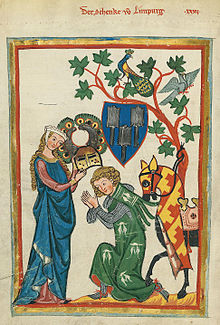
Back فروسية العصور الوسطى Arabic Caballería medieval AST Рицарство Bulgarian Cavalleria medieval Catalan Sifalri Welsh Ritterlichkeit German Ιπποσύνη Greek Kavalireco Esperanto Caballería medieval Spanish Rüütellikkus Estonian

Chivalry, or the chivalric language, is an informal and varying code of conduct developed in Europe between 1170 and 1220. It is associated with the medieval Christian institution of knighthood, with knights being members of various chivalric orders,[1][2] and with knights' and gentlemen's behaviours which were governed by chivalrous social codes. The ideals of chivalry were popularized in medieval literature, particularly the literary cycles known as the Matter of France, relating to the legendary companions of Charlemagne and his men-at-arms, the paladins, and the Matter of Britain, informed by Geoffrey of Monmouth's Historia Regum Britanniae, written in the 1130s, which popularized the legend of King Arthur and his knights of the Round Table.[3]
The code of chivalry that developed in medieval Europe had its roots in earlier centuries. It arose in the Carolingian Empire from the idealisation of the cavalryman—involving military bravery, individual training, and service to others—especially in Francia, among horse soldiers in Charlemagne's cavalry.[4]: 2 [5]
Over time, the meaning of chivalry in Europe has been refined to emphasize more general social and moral virtues. The code of chivalry, as it stood by the Late Middle Ages, was a moral system which combined a warrior ethos, knightly piety, and courtly manners, all combining to establish a notion of honour and nobility.[Note 1]
- ^ Keen 2005, p. 44.
- ^ Cecil, Weatherly (1911). . Encyclopædia Britannica. Vol. 15 (11th ed.). pp. 851–867.
- ^ Keen 2005, p. 102.
- ^ Cite error: The named reference
Gautier1884was invoked but never defined (see the help page). - ^ Flori (1998)
- ^ Huizinga (1924), p. 28
Cite error: There are <ref group=Note> tags on this page, but the references will not show without a {{reflist|group=Note}} template (see the help page).